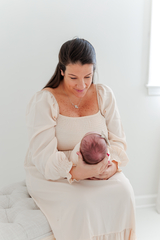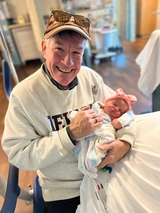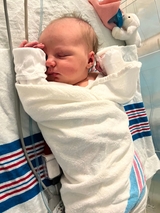Generations of Strength: Kristen’s Journey with Congenital Hyperinsulinism
Generations of Strength: Kristen’s Journey with Congenital Hyperinsulinism
For Kristen Parkes, congenital hyperinsulinism (HI) has been a part of her life for as long as she can remember. It’s a rare condition—but not in her family. From her father, Brad, to her own daughter, Rian, HI has been woven through generations, making the expertise and care provided here at Children’s Hospital of Philadelphia (CHOP) an invaluable part of their lives.
A lifelong journey with HI

Kristen’s HI journey began at birth. When she was born, doctors noticed her blood sugar levels were dangerously low—down to 8 mg/dL--and diagnosed her with hypoglycemia (blood glucose should typically be kept between 70 and 150 mg/dL; anything below that is considered hypoglycemia in babies.) A resident familiar with HI had recently trained at CHOP and recognized the signs, leading to Kristen’s quick transfer to CHOP for specialized care. At CHOP, she was officially diagnosed and placed on diazoxide, a medication that would become a crucial part of her life.
Growing up, HI was just another part of her routine. “I didn’t know anything different,” Kristen shares. “I took medicine twice a day, every day. I had to make sure I ate properly. My parents were pretty laid back about it, but they always knew when my blood sugar was dropping. If I got moody or out of sorts, they’d check in on me.”
Kristen’s father had also been diagnosed with HI and had undergone a pancreatectomy, which left him symptom-free. Her older brother carried the HI gene but never presented with low blood sugar. Her grandmother and uncle also had HI, making Kristen part of at least three generations affected by the condition. Despite their shared family history, Kristen was the only one in her immediate family who needed daily medication.
Managing HI over the years

Kristen’s treatment evolved under the care of CHOP specialists, including Diva D. De León-Crutchlow, MD, MSCE, Chief of the Division of Endocrinology and Diabetes and Director of the Congenital Hyperinsulinism Center. Kristen attempted periods where she’d stop taking diazoxide during her teenage years and young adulthood, but frequent low blood sugar episodes made it clear she needed the medication. Access to diazoxide, however, wasn’t always easy. “HI is so rare that the medication was extremely expensive,” she explains. “At one point, when I was off my parents’ insurance, it was $600 per 30 mL bottle.”
Over time, she discovered that diet played a key role in managing her blood sugar. Complex carbohydrates and fiber helped stabilize her levels, while strenuous exercise often led to drops. These insights would later influence how she would manage HI during pregnancy and in raising her daughter.
Kristen eventually became a nurse, and her medical background gave her an added layer of confidence and understanding when navigating her own health—and later, her daughter’s. She had a deeper perspective when it came to understanding the condition and advocating for her family’s care.
A mother’s perspective: passing on HI

When Kristen became pregnant with her first child, she immediately reached out to Dr. De León-Crutchlow. The genetic odds were clear: there was a 50% chance her baby would inherit HI. With CHOP’s guidance, she had a plan in place before delivery. “I was nervous, but I felt reassured knowing we had a roadmap,” she recalls.
Rian was born with HI and, as anticipated, presented with hypoglycemia at birth. She was quickly transferred to the Division of Endocrinology and Diabetes here at CHOP for a full diagnosis and treatment. “As a first-time parent, it was terrifying,” Kristen admits. “But I also felt so grateful that we lived just 20 minutes from CHOP, the best place in the world for HI care.” Rian was started on diazoxide—the same medication Kristen has taken since infancy—and responded well.
By the time she was pregnant with her second daughter, Parker, Kristen and her husband felt more prepared. Parker was monitored closely but ultimately did not have HI. “We had been through it once, so we knew how to handle things if she did have it,” Kristen says. “But when she passed her fasting test and later tested negative genetically, it was a huge relief.”
CHOP’s impact and looking to the future
Kristen has maintained a close relationship with the team at the Congenital Hyperinsulinism Center, working with specialists who have cared for her family across generations.
Dr. De León and her team are so responsive,” she says. “I can email them about anything—prescriptions, testing supplies, questions—and they always get back to me. It’s amazing to have that level of support.
She also remains involved in HI research, participating in studies to advance treatment options. “Diazoxide has been around for decades, and while it works for us, I’m excited to see new treatments on the horizon,” she says. “If there were a better option—something longer-lasting or more affordable—I’d love to see that available for families in the future.”
Advice for other families

To parents of newly diagnosed children, Kristen offers words of encouragement: “At the end of the day, parents know their kids best. The doctors are experts in HI, but you are the expert on your child. Trust yourself and trust your care team. You don’t have to carry the burden alone.”
For Kristen, living with HI has never been about limitations—it’s about adaptability, resilience and community. Whether connecting with another HI parent at the local swim club or navigating the challenges of managing her daughter’s condition, she embraces every step with confidence. “CHOP has been with us every step of the way,” she says. “And knowing that we have them in our corner makes all the difference.”